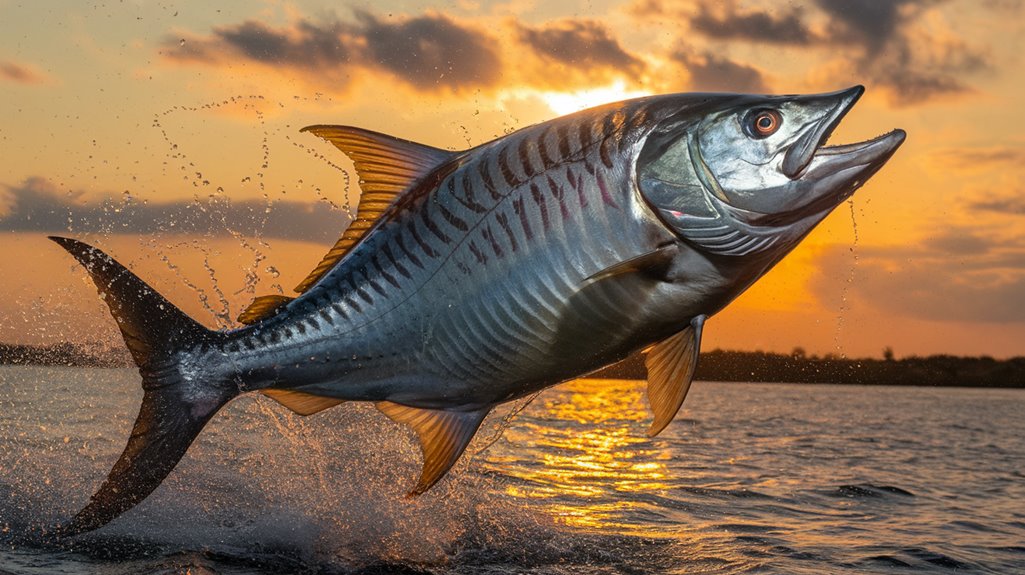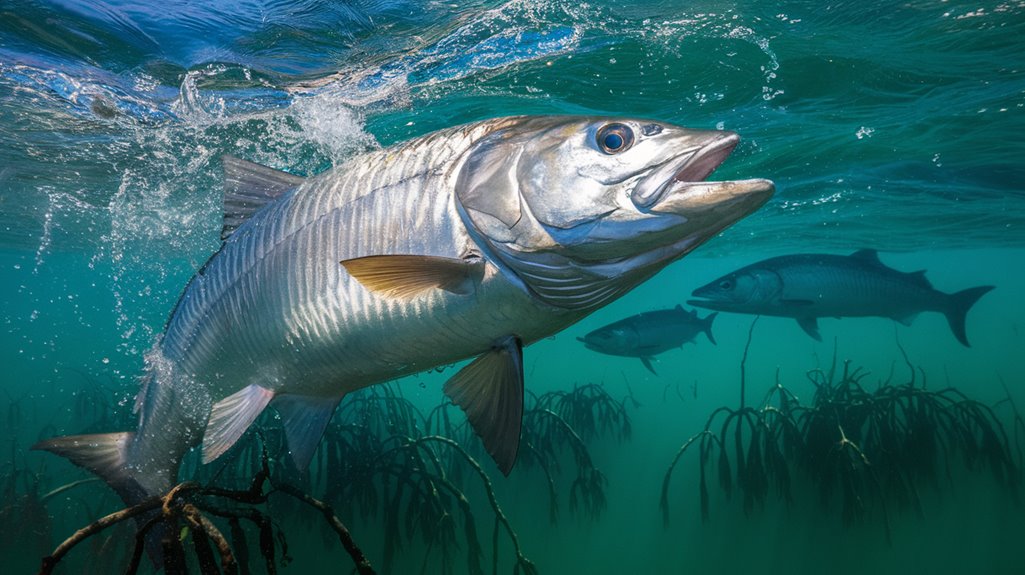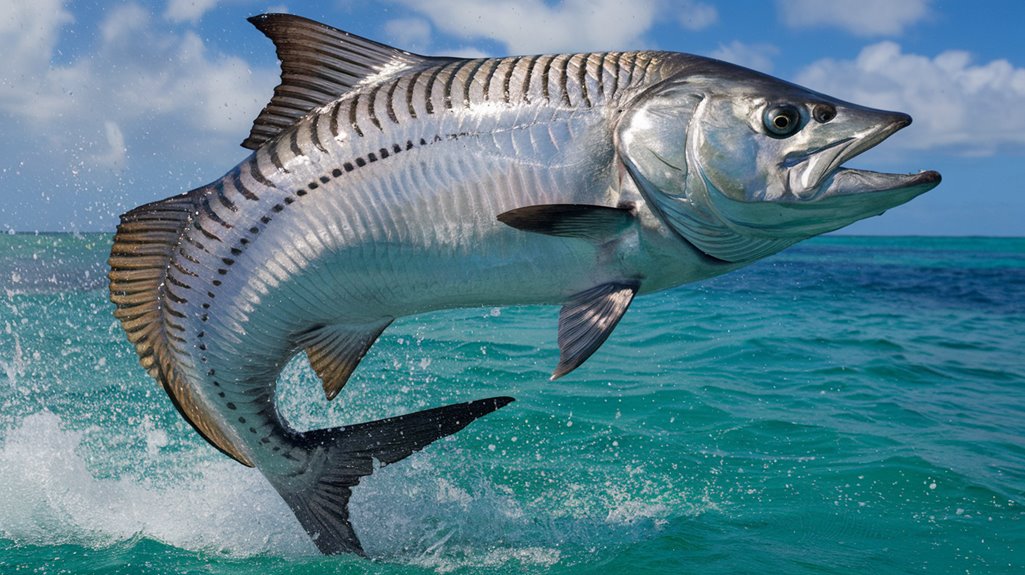You'll encounter few marine species as enigmatic as Megalops atlanticus, the Atlantic tarpon. While you can't serve this prehistoric-looking fish on your dinner plate, its biological adaptations make it a fascinating subject of scientific inquiry. From its specialized swim bladder that functions as a pseudo-lung to its calcium-hardened scales that reflect light like polished shields, the tarpon's evolutionary journey presents a compelling case study in marine vertebrate adaptation.
- Key Takeaways
- The Legend Behind the Silver King
- Physical Characteristics and Armor-Like Scales
- Natural Habitat and Migration Patterns
- Unique Air-Breathing Capabilities
- Life Cycle and Reproduction
- Feeding Behavior and Prey Selection
- Conservation Status and Management
- Best Practices for Catch and Release
- Historical Significance in Sport Fishing
- Frequently Asked Questions
- Conclusion
Key Takeaways
- Tarpon earned the nickname "Silver King" for their brilliant silver scales and spectacular aerial displays when hooked.
- Despite their impressive size up to 286 pounds, tarpon meat is tough, bony, and generally considered inedible.
- Tarpon's value lies in recreational sport fishing rather than food consumption, making them a premier catch-and-release gamefish.
- Their armored scales and complex skeletal structure make processing tarpon for food impractical and commercially unviable.
- Conservation regulations in places like North Carolina prohibit commercial sale of tarpon, emphasizing their recreational rather than culinary importance.
The Legend Behind the Silver King

How did a prehistoric fish species come to be crowned as marine royalty? You'll find the answer in the Tarpon's remarkable 18-million-year evolutionary journey, which has cultivated its distinctive silver-scaled appearance and exceptional fighting abilities. The Silver King earned its noble title through spectacular aerial displays during powerful fights with recreational anglers, launching its massive body skyward when hooked. With specimens reaching up to 286 pounds, you're witnessing a demonstration of nature's engineering prowess. Today's catch and release practices by conscientious anglers help maintain this ancient species' role in the marine ecosystem. The Tarpon's enduring presence, particularly in Florida's waters, exemplifies the success of sustainable fishing practices while preserving its status as the most sought-after gamefish in coastal waters.
Physical Characteristics and Armor-Like Scales
The majestic appearance of the Silver King stems directly from its extraordinary physical adaptations. You'll find its most distinctive feature in the massive armored scales, reaching up to three inches in diameter, which display a mesmerizing greenish-blue dorsal surface evolving into brilliant silver sides. These scales aren't just for show – they're part of the tarpon's 18-million-year evolutionary success story.
The fish's body structure reveals precise adaptations for predatory efficiency. You can observe its specialized scoop-shaped mouth, featuring an elongated bony plate in the lower jaw that's perfectly engineered for capturing prey. The tarpon's hydrodynamic design is further enhanced by its deeply forked tail and extended dorsal fin ray, enabling powerful propulsion through diverse marine environments.
Natural Habitat and Migration Patterns

You'll find tarpon thriving across diverse coastal environments, from brackish wetlands and estuaries to the open ocean, demonstrating their remarkable euryhaline adaptability. These migratory fish exhibit distinct seasonal movement patterns, particularly evident in regions like Tampa Bay and the Florida Keys, where they traverse shallow waters in search of prey. Their distribution primarily spans the warmer Atlantic waters, with concentrated populations in Florida, the Caribbean, and the Gulf of Mexico, where they undertake offshore spawning migrations during summer moon phases.
Coastal Waters and Estuaries
Living across multiple aquatic environments, tarpon demonstrate remarkable adaptability in their habitat selection, primarily inhabiting the warm coastal waters stretching from Florida through the Caribbean and into the Gulf of Mexico. You'll find these remarkable fish thriving in diverse estuarine habitats, from shallow wetlands to complex coral reef systems, particularly in regions like Tampa Bay and the Florida Keys.
As juvenile tarpon mature, they'll migrate from their nursery grounds to inshore waters, displaying precise habitat shifts that coincide with their sexual development between ages 7 and 12. Their exceptional physiological tolerance allows them to occupy waters with varying salinity levels and reduced water quality. This adaptability enables tarpon to flourish in coastal environments where other species can't survive, including their notable trans-isthmian migrations through the Panama Canal.
Seasonal Movement and Migration
Seasonal movement patterns define tarpon's life cycle, with these majestic fish undertaking extensive migrations that coincide with temperature fluctuations and reproductive cycles. You'll find these remarkable creatures exhibiting complex migratory behaviors as they adapt to seasonal changes, moving between different aquatic environments throughout the year.
Key migratory patterns include:
- Movement to warmer coastal waters during May-August spawning periods
- Offshore aggregation near full moons for reproductive activities
- Juvenile congregation in brackish waters and estuarine habitats
- Adult preference for deeper marine environments during non-spawning periods
Their exceptional adaptability enables them to traverse international waters, making them a shared ecological resource. You'll observe their systematic shifts between habitats, demonstrating their remarkable capacity to utilize diverse marine ecosystems throughout their life stages.
Unique Air-Breathing Capabilities
While most fish rely solely on their gills for oxygen extraction, tarpon have evolved a remarkable physiological adaptation that sets them apart: a specialized swim bladder that functions as a primitive lung.
You'll find this evolutionary advancement enables tarpon to gulp air at the surface, supplementing their oxygen intake when dissolved oxygen levels become insufficient. The dual-purpose swim bladder not only facilitates respiratory function but also provides precise buoyancy control, enhancing their predatory effectiveness. This adaptation proves particularly beneficial for juvenile tarpon, allowing them to colonize oxygen-depleted environments where other species cannot survive. From coastal waters to stagnant backwaters, this air-breathing capability has contributed to the species' remarkable resilience over 18 million years, demonstrating the evolutionary significance of their unique respiratory system.
Life Cycle and Reproduction

You'll find tarpon engaging in remarkable spawning behaviors during the May to August season, when mature females release up to 12 million eggs in deep offshore waters during full moon phases. The newly hatched larvae, measuring approximately quarter-inch in length, drift passively with oceanic currents while undergoing critical developmental stages. Within days of hatching, these juvenile tarpon develop essential features including fins and a swim bladder, marking their shift toward coastal habitats where they'll continue their growth trajectory.
Spawning In Deep Waters
During the peak summer months of May through August, tarpon engage in a remarkable spawning ritual that occurs in the depths of open ocean waters. You'll find these magnificent creatures gathering in large aggregations, synchronizing their reproductive activities with full moons to optimize breeding success.
Key aspects of tarpon spawning include:
- Female tarpon's extraordinary fecundity, producing over 12 million eggs per spawning event
- Strategic timing of reproduction during lunar cycles for maximum survival rates
- Spawning site selection in deep, offshore waters away from coastal predators
- Initial larval stage development, with quarter-inch hatchlings dispersing via ocean currents
Sexual maturity occurs between ages 7-12, ensuring multiple reproductive contributions throughout their lifespan. This cyclical process maintains population stability and genetic diversity in tarpon communities.
Early Development Stages
As newly spawned tarpon eggs drift in oceanic currents, they begin a remarkable metamorphosis that spans several distinct developmental phases. The larvae hatch at merely quarter-inch lengths, starting on a vital journey through offshore waters. You'll find these minuscule organisms transforming rapidly as they develop necessary survival features.
When juvenile tarpon shift to inshore habitats, they undergo significant physiological changes, developing fins and a swim bladder within days. Large females spawn seasonally between May and August, typically during full moons, producing over 12 million eggs that guarantee population replenishment. Sexual maturity occurs between ages 7 and 12, though some specimens can live up to 80 years. This extended lifespan, combined with high egg production from mature females, plays an essential role in maintaining sustainable tarpon populations across their range.
Feeding Behavior and Prey Selection
While many fish species maintain consistent feeding patterns, tarpon exhibit complex predatory behaviors that evolve throughout their life cycles. You'll notice their feeding behavior shifts dramatically from juvenile to adult stages, reflecting their adaptive survival strategies. As juveniles, they target smaller prey like zooplankton and insects, but shift to a strictly carnivorous diet as adults.
- Nocturnal hunting patterns dominate adult tarpon feeding behavior
- Primary prey includes mullet, pinfish, and various shellfish species
- Juvenile tarpon focus on planktonic organisms and insects
- Prey selection varies by habitat and seasonal availability
These feeding patterns make tarpon fishing particularly challenging, as they're known for unpredictable feeding responses. When you're targeting them, you'll find success using bait that mimics their natural prey, such as threadfin herring or crabs.
Conservation Status and Management
The conservation status of Atlantic tarpon reflects a complex intersection of regulatory gaps and protective measures across coastal jurisdictions. You'll find that while North Carolina hasn't established thorough management protocols, they've prohibited commercial sale to safeguard these magnificent fish. The Bonefish and Tarpon Trust advocates for proactive management strategies that protect migratory patterns and sustain populations across state boundaries.
You can observe successful conservation efforts in Tampa Bay, where pollution control and net bans have contributed to population recovery. Current handling guidelines emphasize minimizing stress during catch-and-release activities – you shouldn't remove tarpon from water during release. As catch-and-release regulations evolve, they're becoming more stringent to guarantee the species' long-term survival, reflecting a growing understanding of tarpon's ecological significance and vulnerability to fishing pressure.
Best Practices for Catch and Release
Proper catch-and-release protocols greatly influence tarpon survival rates post-interaction. To optimize their chances of survival, you'll need to minimize handling time and maintain aquatic contact. When handling these magnificent fish, use wet hands to prevent epidermal damage and provide adequate support beneath their cranial and ventral regions.
- Pre-plan photographic documentation before extracting specimens from their aquatic environment
- For specimens exceeding 40 inches, maintain complete submersion during hook extraction per Florida regulations
- Support the specimen's weight distribution to prevent anatomical stress or injury
- When equilibrium is compromised, facilitate recovery by ensuring consistent water passes through their branchial apparatus
If you observe signs of distress, maintain submersion while supporting the specimen until it demonstrates sufficient recovery to maintain upright swimming posture independently.
Historical Significance in Sport Fishing
Modern catch-and-release practices evolved from a rich historical legacy of tarpon sport fishing dating back to the late 19th century. You'll find that as tarpon migrate in large schools along Florida's coastline, they've captured anglers' attention for over 125 years due to their impressive size and fighting ability. The species' significance in sport fishing reached new heights when the IGFA recorded a 286-pound specimen in 2003, cementing the tarpon's status as a premier game fish. Florida's fishing culture has adapted from early kill tournaments to sustainable practices, implementing regulated catch-and-release protocols. This evolution reflects both conservation awareness and the enduring appeal of pursuing these magnificent fish, which continue to draw enthusiasts to renowned locations like the Florida Keys and Tampa Bay.
Frequently Asked Questions
Why Do We Not Eat Tarpon?
You won't find tarpon appealing for consumption due to their oily flesh's strong, unpleasant aroma and numerous intramusculoskeletal bones, making extraction and preparation of edible portions commercially impractical.
Can You Eat Silver King?
While you can technically consume Megalops atlanticus (Silver King), it's not recommended due to its tough, bony structure and malodorous flesh. Most anglers practice catch-and-release for this species.
Why Are Tarpons Called the Silver King?
You'll recognize tarpons as "Silver Kings" due to their distinctive reflective scales, substantial size exceeding 300 pounds, and dominant aquatic presence, combined with their spectacular aerial maneuvers during interactions.
What Happened to the Tarpon in Texas?
You'll find Texas's tarpon populations experienced severe declines from overfishing, habitat degradation, coastal development, and altered water flows, though recent conservation efforts, including catch-and-release regulations, aim to restore their numbers.
Conclusion
As you've examined Megalops atlanticus, you'll recognize its importance extends beyond its taxonomic classification. Through analysis of its physiological adaptations, including the specialized swim bladder for aerial respiration and dermal ossification patterns, you'll understand why this species remains crucial to coastal ecosystem dynamics. Your adherence to scientifically-validated catch-and-release protocols guarantees the perpetuation of this remarkable Elopiformes specimen for continued research and observation.

